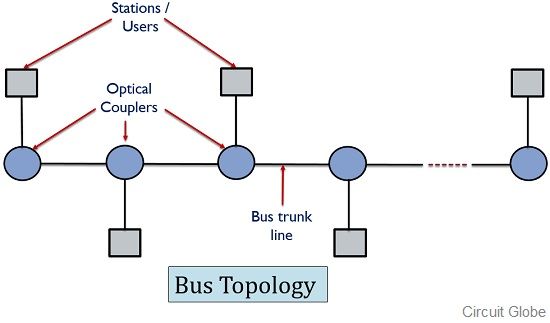Definition: An Optical Network is basically a communication network used for the exchange of information through an optical fiber cable between one end to another. It is one of the quickest networks used for data communication.
As we already know that data signal through an optical fiber is transmitted in the form of light pulses. So, optical networks are used in order to have optical signal transmission.
Now, the question arises that what is the need for the optical network when we have other communicating networks.
So, the answer to this question basically relies on the ease of transmitting the signal in the form of light pulses. Today’s internet era is based on fiber cable and only the optical signals can be transmitted through these cables. Thus, the need for optical network emerges.
As we know that transmission through fiber cable is an easier task due to the low production cost of the cable. Along with that, a fiber cable permits large data carrying capacity and longer distance transmission than other cables.
Thus, we use fiber cables and hence, the optical network is an important aspect of the communication system.
Elements of optical network
An optical network is basically composed of the following elements:
- Stations: Stations in an optical network serves as the source and destination of the information being transmitted and received. Stations are basically those devices that are used by the users of the network. For example, a computer or any other telecommunication device.
- Trunk: A trunk is basically a transmission line i.e., optical fiber cable in order to transmit the optical signal. A network is composed of one or multiple trunks for signal transmission over large distance.
- Node: Node is nothing but acts as a hub for multiple transmission lines inside the network. In case of a single transmission line, an optical network does not require nodes, as in this case stations at both the ends can be directly connected to the fiber cables.
- Topology: When multiple fiber cables are employed in an optical network, then these are connected through nodes. But the way in which the multiple nodes are connected together denotes the topology of the network.
- Router: A router is basically placed inside an optical network that provides a suitable path for signal transmission.
Optical Network Topologies
As we have already discussed in the previous section that topology is the arrangement of multiple optical fiber transmission lines in an optical network. So, let us now move forward to understand the various topology configurations:
Bus Topology: In a bus topology, the various nodes are connected through a single trunk line with the help of optical couplers. This allows a convenient as well as a cost-effective method to transmit the signal. However, in a bus topology, it is difficult to determine the faulted node as well as it also takes time to restore the transmitted signal from that particular node.
Ring Topology: In a ring topology, one single node is joined to its neighbouring node thereby forming a closed path. So, the transmitted information in the form of light is sent from one node to another. Also, optical couplers are installed within the network in order to the couple the transmitted optical signal from one node to another.
Star Topology: In star connection, the various nodes of the network are connected together with a single central hub. This central hub can be active or passive network. This central hub then controls and directs the transmitted optical signal inside the optical network.
Mesh Topology: In a mesh topology, an arbitrary connection is formed between the nodes in the network. This point to point connection can be changed according to the application. This shows the flexible nature of star topology as in case of failure of one node, others can be used for signal transmission.
Basically, in mesh connection, failure of any link or node is generated then firstly that particular failure is detected and then the signal traffic is diverted from failed node to another link inside the connection.
Categories of Optical Network
The categories of optical network are based on the area that connects the user of the network. These are classified as:
- Local Area Network (LAN): Basically a LAN connection provides the interconnection of users that are present in localized areas like a building, a department or an office etc.
The example of networking topology of LAN is Ethernet. As in LAN, users are permitted to share the resources together like servers etc. These are personally owned by an organization. It is quite inexpensive. - Campus network: This network category is formed by the interconnection of multiple LAN’s. This is basically extended to a large level but is still confined within a localized area. It is also governed by a single organization.
The examples of campus network are university campus, a government organization, or a medical centre etc.
- Metropolitan Area Network (MAN): It is also known as a metro network and covers a greater area than a campus network. It permits the interconnection of several buildings that are present in different cities.
Due to its large operating area, MAN is controlled by several communication organizations.
- Wide Area Network (WAN): Unlike MAN, a WAN provides interconnection of users from neighbouring cities as well as cross-country regions. It is employed to establish communication over a large geographical distance and is controlled and maintained by some private organizations or telecommunication service providers.
Advantages of Optical Network
Using an optical networking system is highly advantageous. The advantages are as follows:
- An optical transmission system supports high bandwidth.
- The transmitted signal can be transmitted to longer distances.
- This networking system is more flexible than other transmission systems.
So, we can say an optical network provides better signal transmission capability to longer distances thus is widely used nowadays.






